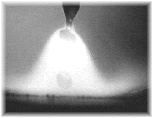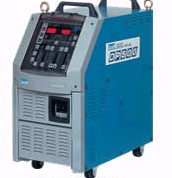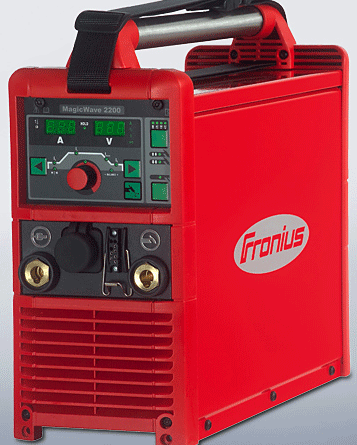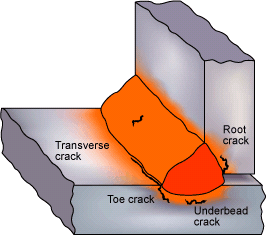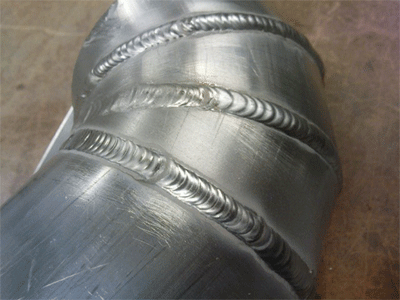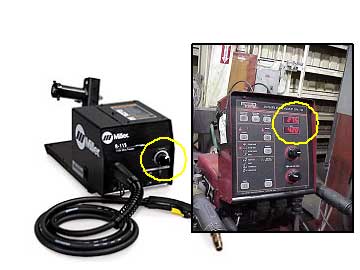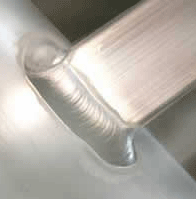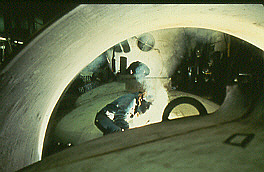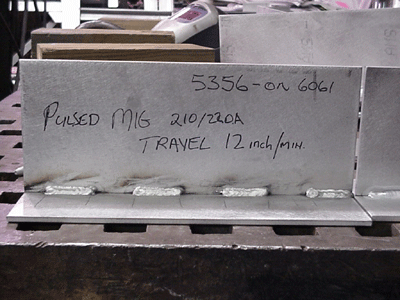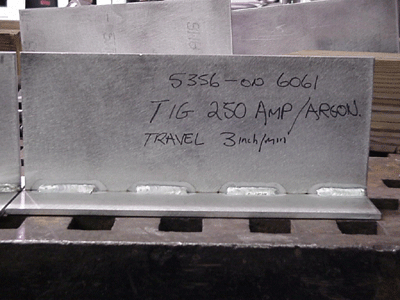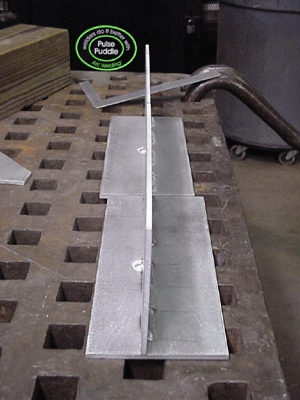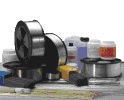 |

|
Welcome to the world's largest web site on MIG , Flux Cored and TIG. Weld Process Controls & Best Weld Practices. To get to the root cause of GMAW (MIG) & Flux Cored (FCAW) weld issues, requires Weld Process Control - Best Practice Expertise, & lots of Weld Reality. The site provides the MIG - Flux Cored and TIG weld information and data required to attain the highest possible manual and robot weld quality, always at the lowest possible weld costs.
This web site was first established in 1997 by Ed Craig. Contact Ed. ecraig@weldreality.com
Aluminum WELDING. Section 2.
ED'S MIG EQUIPMENT RECOMMENDATIONS FOR COST EFFECTIVE PULSED ALUMINUM WELDS.
.OTC Daihen and Fronius make the best pulsed MIG power sources available for both stainless and aluminum welds on "thin gage" or "high volume" applications. The OTC equipment is much lower cost and the most cost effective pulsed MIG equipment. At the time this was written, OTC provided superior pulsed MIG output characteristics than comparative North American pulsed MIG equipment and when I figured I needed electronics as part of a MIG weld, then OTC was my choice..
Note: For more weld equipment data see weld equipment section. Click here.
ALUMINUM WELD TIPS AND DATA:
Warning: To avoid cracks. Mixing alloys as typically occurs in welding dissimilar aluminum alloys can increase the crack sensitivity. When selecting the aluminum filler metal, examine the base alloy and filler alloy combination and avoid a final mix of alloys high in both Mg and Cu content.Poor wire feed is the prime cause of wire burn back to the contact tip.
In contrast to the 5xxx series, the 4xxx filler metals typically have lower ductility and less shear strength in fillet welds, these wires will also have more wire feed issues than the same size 5xxx wires.
The 5xxx filler metals provide the highest weld strength for none heat treatable alloys. Magnesium 0.5 to 3% provides a weld which is crack sensitive. The Al - Mg alloys with less than 3% Mg can be welded with the Al - Si 4xxx alloys as the magnesium silicides increase ductility and increase the crack sensitivity.
For optimum wire feed, use minimum amount of brake on wire spool.
To feed the soft alum wire, use rigid, hard plastic instead of softer nylon.
For inlet - outlet guides ensure nylon or teflon is used.
To minimize the wire tension effects on the soft alum wire, use U groove drive rolls, with
chamfered edges. Use minimum wire feed tension.
Manual welding aluminum with a traditional MIG torch and an 0.046 wire, use a conventional
10 foot torch with a plastic liner.
If a robot is used and the wire feed control is mounted on the robot, a push pull system is
not necessary if an Alcotech or similar MIG wire controlled tension, dee-reeler is utilized.
ALUMINUM WELD TIPS AND DATA:
Use higher flow rates for MIG welding Aluminum 40 - 60 cfhr for argon. For helium argon mixes, 50 - 100 cuft/hr. If you use an argon flowmeter and a helium mix and set at 40 cuft an hr you may get 50% more gas than you need. For helium argon mixes use a flow meter designed for helium.
Avoid rigid clamps on fixtures, use minimum restraint to avoid cracking.
With aluminum weld heat buildup in the part is rapid consider your weld sequence carefully, do the thin parts or gaps first. Consider the use of heat quench components on your fixtures in close proximity to the welds.
Excess restraint on aluminum fixtured parts can result in longitudinal cracking.
Increasing the weld size will decrease the opportunity for longitudinal cracks.
To reduce aluminum transverse cracks reduce weld heat input. Lower parameters and increase weld travel rates.
To reduce crater cracks use a back step technique, and with a robot use lower weld data for the crater fill data.
To minimize center line cracking ensure sufficient convex fillet throat and use low voltage.
To increase weld penetration, increase wire feed rate, use the lowest possible voltage, lower weld speed.
Weld technique and craters: With aluminum welding, crater cracking is the cause of many crack influenced weld / part failures. Crater cracks results from the concave thin weld ends and the high thermal expansion and contraction of the aluminum as the weld end cools and tears apart.
Welders should buildup craters to form a convex or mound shape. As the weld cools, the increased weld mass from the convex shape of the crater weld will compensate for contraction forces. Use the crater fill data equipment options, a back step technique or start and stop the weld at the weld completion.
.
ALUMINUM WELD TIPS AND DATA:
Pulsed MIG is especially suited to aluminum weld applications 0.040 to 0.100. For alum parts Over >4 mm, traditional MIG spray transfer should provide superior fusion and less porosity.
In contrast to MIG welding steels, the pulsed MIG process provides real welding benefits. The lower, attainable pulsed spray current reduces weld burn-through and the lower pulsed current with high conductivity - lower melting temperatures means you can use larger wires. Also with pulse less weld smoke and less ozone is generated
Pulsed MIG ideal for vert up welds, however with aluminum spray transfer can also be used dor all position welds.
With aluminum avoid weld weaves use stringer beads for multi-pass welds.
With aluminum use the largest wire sizes to avoid feed problems. Consider 0.046 the smallest practical alum weld wire.Wire sizes smaller than 0.046, < 1.2 mm can cause wire feed problems.
Use an helium argon mix for alum applications thicker than 6 mm and for applications which require more weld penetration. Best helium mix, 60 helium 40 argon, Note it's important to keep sufficient argon for it's cleaning action on the surface alum oxides.
Use the largest size nozzle to ensure complete gas coverage of the weld.
If wire burn back - contact tip issues occur, consider using the next size contact tip or drill your tips 0.01 larger than the origional tip bore.
To avoid robot start issues, run the wire in at a faster wire feed rate than the weld wire feed rate.
As aluminum weld starts and weld ends can have lack of weld fusion, its beneficial to add to the length of the welds and with a robot. At the weld starts, use seperate wire feed - voltage data and techniques to deal with these concerns.
When the aluminum is anodized, silicon in the 4xxx alum wires can make the weld appear darker. A change to a 5xxx wire will improve the appearance.
.
MORE ALUMINUM WELD TIPS AND DATA:
Use Austenitic (300 series) stainless for back up bars or clamp materials close to the aluminum welds.
>
2XXX - 7XXX aluminum, watch out for start / stop weld cracks, consider run on run off tabs.
For base alloys with sensitivity to hot cracking such as 2xxx, consider 4xxx filler such as 4145 or 4047. These alloys have a very low weld solidification temperature. A filler with a very low weld solidification temperature ensures the weld solidifies last after the base metal has solidified and reached its max strength.
5XXX aluminum, max preheat / interpass temp 150F 65C to avoid cracks.
With aluminum alloys with 3.5 - 5.5 Mg to avoid cracking don't preheat over 250F (120C).
With aluminum alloys with 3.5 - 5.5 Mg to avoid cracking ensure max interpass temp is 300F 150C.
The common 6xxx heat treatable alloys lose approx. half their strength after welding. Post weld heat treat can improve the strength, if post heat considered ensure the filler is designed for the heat treatment.
Filler 4643 is for welding 6xxx alloys that require post heat treatment to attain improved strength.
Filler 5180 is used for the 7xxx series. It responds to heat treatment.
To lower HAZ cracks, use filler with the same or lower melt temp as base metal.
To prevent weld cracks, filler should have higher alloy content than the base metal.
4XXX - 5XXX is more crack sensitive when weld contains 0.5 to 2 % Si - Mg.
On thin alum sheet ER4047 is an alternative to ER4043.
5XXX or 6XXX pipe may also use ER5656
5183 or 5556 may be used instead of ER5356.
Don't use 5356 - 5183 5556 5654 for high temperature applications >150 F as stress corrosion cracking can occur. Consider alloy 5554 as
it contains less than 3% Mg.
Be aware of trying to repair the none weldable alum grades. Those high cost alum components found on aircraft, hang gliders, boats or sports equipment etc may contain exotic alloys that can lead intergranular micro cracks and failure if heat is applied.
MORE ALUMINUM WELD TIPS AND DATA:
As thermal conductivity is very high for alum, the first 1/4 (6 mm) of the weld should provide a lack of weld fusion concern. That concern is increased when the aluminum components are >3 mm. The thicker the part, the greater the heat sink. The lack of weld fusion is typical in the first 6 mm of the weld. If your aluminum welds are >3mm and subject to stress or fatigue, the following points will help in improving weld start fusion and weld crater issues. Some alum weld equipment provides a hot start feature which will enable you to set more weld current for the start.
With robots you can increase your arc start times and set a separate, higher weld parameter weld schedule for the first 6 mm of the weld.
If you need a weld three inches long on a part subject to stress, the designer would be wise to make the weld three and a half to four inches long to compensate for weld start / stop issues.
To minimize the effects in the aluminum weld crater from the high thermal expansion and weld shrinkage (5 - 7%), try the following.
If purchasing new MIG weld equipment ensure it has a a good crater fill feature which lowers the current in a controlled manner over a minuscule time period at the end of the weld. Those TIG welders who have used the weld current foot controls to ramp down the weld current at the crater will be aware of the crater benefits when applied to a MIG weld.
If your robot weld equipment does not provide the current ramp down feature, then set a separate weld schedule to commence for the last 6 mm of the weld. This weld schedule would either provide a lower wire feed and voltage than the weld , or the schedule would have the same wire feed setting as the weld with 2 to 6 lower volts than the weld voltage.
If your parameter control at the crater does not leave a convex weld, use the back step technique in which you get to the end of the weld and then come back 6mm with a lower parameter setting.
Due aluminum's higher thermal conductivity, lower melting temperature and lower electrical resistivity than a steel, the alum MIG wire wire stick out is is extremely sensitive to current and voltage changes. This is one reason instability issues are a concern with the pulsed MIG process.
Warning: To avoid cracks. Mixing alloys as typically occurs in welding dissimilar aluminum alloys can increase the crack sensitivity. When selecting the aluminum filler metal, examine the base alloy and filler alloy combination and avoid a final mix of alloys high in both Mg and Cu content.
IF YOU USE ROBOTS FOR ALUM WELDS, ARE YOU AWARE OF THE FOLLOWING?
IF YOU HAVE A FULL UNDERSTANDING OF ALUMINUM AND ROBOT WELD PROCESS CONTROLS, YOU COULD USE SEPARATE WELD PARAMETER SCHEDULES IN A SINGLE WELD TO OVERCOME MANY OF THE UNIQUE ALUMINUM HEAT RELATED WELD AND WELD START ISSUES?
IF THE WELD HEAT IS BUILDING UP DURING THE WELD, WHEN YOU GET TO THAT POINT USE A SEPARATE, LOWER DATA WELD SCHEDULE.
IF YOU HAVE WELD START ISSUES, USE A HIGHER WIRE FEED RUN IN WELD SCHEDULE AT THE START.
Question from Deborah. Mr. Craig, I am in the process of preparing WPS's for welding Aluminum Bus ASTM B 236 gr 1350 . As AWS does not list this material in D1.2, nor does the ASME BPV Section II B I have purchased the Material Spec from ASTM… My question is in regards to the PQR Test requirements. D1.2 Table 3.4 calls for Tensiles and Side bends. Would the tensile property limits as set forth in B 236 for the material be the criteria for the weld tests ( PQR Record)? We will be welding 2" thick members using 1100 filler. Thanks Deborah Robinson
Ed's Answer: The 1100 filler is a good match for electrical conductivity, however you will get far better weldability and weld properties from a 4043 wire for your 1350 aluminum applications. Irrespective of the weld wire used, as the part is 2 inches thick I would use MIG and use a 60 helium 40 argon mix As for the best weld process of course you can TIG weld with argon but to speed the job up consider high energy MIG spray transfer, with 045 wire. As for the procedure set the wire in the spray mode, (data available in this section) Remember with this applications it's all about attaining consistent weld penetration. What ever process you use first pre-qualify the weld. You should weld a small section and cut it and check the weld fusion profile attained. Regards Ed
Question:
Ed when we liquid penetrant the "TIG" aluminum welds, in the heat affected zone (HAZ), we sometimes see evidence of micro cracks. What can we we too prevent this?Ed's Answer. The micro cracks in the HAZ are frequently caused by excess weld heat (CURRENT) or by the High Frequency (HF) intensity. A reduction in either the GTAW weld current, an increase in weld speed, or a reduction in the TIG, HF intensity should eliminate the micro crack problems in the alum HAZ.
ALUMINUM WELD TIPS - DATA:
For optimum aluminum welds, focus on the above "optimum wire feed /amp" data.
For welding > 1/4 consider the 062 wire with traditional spray transfer. With regular spray transfer travel speeds much greater than pulsed can be attained, >50 ipm are attainable. Also from a weld penetration and arc stability perspective spray can be superior to pulsed.
To improve weld fusion at arc starts consider these techniques. With manual MIG welding use a shorter wire stick out and a back hand technique for the weld starts. With a robot use hot start data, combined with back hand and a shorter WSO at the arc start.
If welding less than 3 mm, first choice would be the pulsed process, however short circuit can also be used.
-
If you use a spool gun or regular MIG gun and you don't know the wire feed setting you are using, remember, it's important to always be aware of the wire feed rate. Check the wire feed rate by how much wire comes from the gun in 10 seconds, then to make weld parameter, wire feed adjustments, adjust the wire feed in increments of 10%.
Use the optimum amps for the wire diameter selected. If you are setting pulsed current, the typical opt pulsed range will be the optimum amps minus approx. 30 - 60 amps.
If welding aluminum vertical up with 0.046 wires and a traditional CV power source set the vert up welds with a wire feed of 280 ipm (11 o'clock traditional feeder) 140 amps 23 volts.
If welding short circuit set the weld volts between 14 and 17 volts. Listen to arc sound, if soft plop sound lower volts till crisp consistent crackle sound, if harsh crackle with spatter increase weld volts till crisp consistent crackle sound.
Adjust the spray arc length with a voltage adjustment so the arc length is at its lowest and the weld transfers without disrupting the weld causing weld spatter. To lower the arc length lower the voltage.
ALUMINUM SPRAY TRANSFER MIG WELD DATA:
|
Spray |
Spray Amps |
Spray Volts |
|
|
500-750 |
95-150 |
22-24 |
|
|
400-700 |
120-200 |
23-24 |
|
|
285-600 |
140-270 |
23-25 |
|
|
220-410 |
190-350 |
26-28 |
|
|
||||
.
METRIC CONVERSION WIRE FEED inch/min to mm/sec = x 0.42..
.
.
ALUMINUM HOW MANY POUNDS OF MIG
WIRE REQUIRED PER WELD SIZE?
Aluminum 1/8 3.2 mm fillet = 0.092 lb/ft 0.03 kg/m
Aluminum 3/16 4.8 mm fillet = 0.026 lb/ft 0.04 kg/m
Aluminum 1/4 6.4 mm fillet = 0.05 lb/ft 0.07 kg/m
Aluminum 3/8 9.5 mm fillet = 0.06 lb/ft 0.09 kg/m
Aluminum butt weld 13 mm plate 60 degree single V = 0.3 lb/ft 0.43kg/m
Aluminum butt weld 18 mm plate 60 degree single V = 0.4 lb/ft 0.66kg/m
Aluminum butt weld 25 mm plate 60 degree single V = 0.82 LB/FT 1.2kg/m
Aluminum butt weld 38 mm plate 60 degree single V 1.7 lb/ft 2.6 kg/m
Aluminum butt weld 50 mm plate 60 degre single V 2.8 lb/ft 4.2 kg/m
ALUMINUM "ipm" FEED RATE TO WELD DEPOSITION RATE:
030 0.8 mmwire, ipm x 0.004 = lb/hr
035 0.9 mmwire, ipm x 0.0056 - l/hr
046 1.2mm wire, ipm x 0.0099 = lb/hr
052 1.4mm wire, ipm x 0.012 = lb/hr
062 1.6mm wire, ipm x 0.017 = lb/hr
093 2.4mm wire, ipm x 0.0415 = lb/hr.
ALUMINUM "m/min"FEED RATE TO WELD DEPOSITION RATE:
0.8mm wire, m/min x 0.07 = kg/hr
1 mm wire, m/min x 0.09 = kg/hr
1.2 mm wire, m/min x 0.16 = kg/hr
1.4 mm wire, m/min x 0.23 = kg/hr
1.6 mm wire, m/min x 0.306 = kg/hr
2.4 mm wire, m/min x 0.74 = kg/hr
1990: A MESSAGE FROM ED TO THE MANUFACTURERS OF ALUM MIG WIRES
1990. For decades Aluminum wire manufacturers have provided 0.035 - 0.046 - 0.062 alum wires. If the major aluminum weld wire manufacturers employed good weld process control individuals and employed weld wire marketing managers that actully understood the weld issues that occur with aluminum MIG welds, when the pulsed MIG process was introduced, they would have developed an 0.052 (1.4mm) aluminum filler wire.
An 0.052 1.4 mm aluminum MIG wires would be ideal for many, robot, pulsed automotive applications which to day use the smaller 0.046 wires and have wire feed and burnback issues. As with many of the MIG issues that face this industry, this is just another case of process and application apathy / ignorance by the companies who make weld consusmables. I wonder if there is an aluminum wire marketing person out that can finally offer the alum welding industry something that will actually provide practical welding benefits.
.
.
ALUMINUM ALLOY
FILLER METAL SELECTION
AWS A5-10. Use first choice. Confirm choice with wire manufacturer
Aluminum 2011 / 7075/ 7178 Wrought Alloys
Welding not
recommended
Aluminum Casts - 242 / 520 / 535 / 705 / 707 / 710 / 711 / 713 / 771
Welding not
recommendedAluminum 1060 to 319- 333 - 354 -355 - 380
Use 4145 or 4043Aluminum 1060 to 413 - 443 - 444 - 356 - 357 - 359 -
Use 4043 or 4047
Aluminum 1060 to 514 / 5454 / 5154 / 5254 /
Use 4043 - 5183 - 5356
Aluminum 1060 to 7005/7939/712/6070/
5052/5652Use 4043 - 4047
Aluminum 1060 to
6061 / 6063 / 6101 /6151
6201/ 6951/
Use 4043 - 4047
Aluminum 1060 to 5456
5086 / 5083Use 5356 - 4043
Aluminum 1060 to 5005
5050 / 1100 / 3003Use 1100 - 4043
Aluminum 1060 to 3004
Use 4043
Aluminum 1060 to 1060
Use 1260 - 1060
Aluminum 1060 to 2014 / 2024
Use 4145
Aluminum 1100 and 3003 to 319 - 333 354 - 355 - 380
Use 4145 - 4043
Aluminum 1100 and 3003 to 413 - 443 - 44 -356 - 357 - 359 - 6067
Use 4043 - 4047
Aluminum 1100 and 3003 to 514 - 5545 - 5154- 5254 - 5052 - 5652
Use 4043 - 5183
Aluminum 1100 and 3003 to 6951
Use 4043 4047
Aluminum 1100 and 3003 to 1060
Use 1260 - 4043
Aluminum 1100 and 3003 to 5456 - 5086 - 5083
Use 5356 - 4043
Aluminum 1100 and 3003 to 2014 - 2024 -2219
Use 4145
Aluminum 1100 and 3003 to 5005 - 5050 - 3004
Use 4043 - 5183
Aluminum 1100 and 3003 to 1100 -
3003Use 1100 - 4043
Aluminum 2014 and 2024 to 319 - 33 -354 - 355 - 380
Use 4145 - 2319
Aluminum 2014 and 2024 to 413 - 443 - 444 - 356 - 357 - 359
Use 4145
Aluminum 2014 and 2024 to 6067- 6061 - 6063 -6101 - 6151 -6201 -6951
Use 4145
Aluminum 2014 and 2024 to 2219 - 2014 - 2024 -
Use 4145 - 2319
Aluminum 2090
Use 2319 - 4047- 4145 Note limited crack sensitivity
Aluminum 2219 to 319 - 333- 354 - 355 - 380
Use 4145 - 2319
Aluminum 2219 to 413 - 443 - 444 - 356 - 357 - 359 -
Use 4145 - 4043
Aluminum 2219 to 514 7005 - 7939 - 712
Use 4043 - 4047
Aluminum 2219 to 6070 - 6063 - 6101 - 6151 - 6201 - 6951
Use 4043 - 4145
Aluminum 2219 to 5456 - 5086 -5083
5005 - 5050 3004Use 4043
Aluminum 2219 to 5154 - 5254 - 5052
5652Use 4043 - 4047
Aluminum 2219 to 2219
Use 2319
Aluminum 2519 - T87 to 2519 - T87
Use 2319
Aluminum 2519- T87 to 5083 H131
Use 4043
Aluminum 5005 - 5050 - 3004 to 319
333 - 354 - 355 - 380
Use 4043 - 4047
Aluminum 5005 - 5050 3004 to 413 -443 - 444 - 356 - 357 - 359 -
Use 4043 - 4047
Aluminum 5005 - 5050 3004 to 514 - 5154 - 5254
Use 5654 - 5183
Aluminum 5005 - 5050 3004 to 7005 - 7939 - 712 - 5083
Use 5356 - 5183
Aluminum 5005 - 5050 3004 to 6070 - 5052 - 5652 - 5005 - 3004 -
Use 4043 - 5183
.
Aluminum 5005 - 5050 - 3004 to 6061 - 6101 - 6063 - 6151 - 6201 -6951-
Use 4043 - 5183
Aluminum 5005 - 5050 - 3004 to 5456 - 5086 - 5083 -
Use 5356 - 5183
Aluminum 5005 - 5050 - 3004 to 5454 - 5154 - 5254 -
Use 5654 - 5183
Aluminum 5005 - 5050 - 3004 to 3004
Use 4043 - 5183
Aluminum 5052 - 5652 to 319 - 333 - 354 - 355 - 380
Use 4043 - 4047
Aluminum 5052 - 5652 to 413 443 - 444 - 456 - 357 - 359
Use 4043 - 5183
Aluminum 5052 - 5652 to 514 - 5454 - 5154 - 5254 -
Use 5654 - 5183
Aluminum 5052 - 5652 to 7005 - 7039 - 712 - 5086 - 5083
Use 5356 - 5183
Aluminum 5052 - 5652 to 6070 5456
Use 5366 - 5188
Aluminum 5052 - 5652 to 6061 - 6063 - 6101 - 6151 - 6201 - 6951
Use 5356 - 5183
Alum 5083 Use 5556 - 5183 Aluminum 5083 to 413 - 443 - 440 - 356 - 357 - 359 - 514 - 6070 - 5454
Use 5356 - 5183
Aluminum 5083 to 7005 - 7939 - 712 - 5456 - 5083
Use 5183 - 5356
Aluminum 5083 to 6061 - 6063 - 6101 -6151 - 6201 -6951
Use 5356 - 5183
Aluminum 5083 to 5154 - 5254 - 5086
Use 5356 - 5183
Aluminum 5083 to 5083
Use 5183 - 5356
Aluminum 5083 to 6070
Use 5356 - 5183
Use 5556 - 5183 Aluminum 5086 to 413 - 443 - 440 -356 - 357 - 359
Use 5356 - 4043
Aluminum 5086 to 514 - 7005 - 7939 - 712 - 6070 - 6061 - 6063 - 6101
Use 5356 - 5183
Aluminum 5086 to 6151 - 6201 - 6951- 5456 - 5086
Use 5356 - 5183
Aluminum 5086 to 5454 - 5154 - 5254 -
Use 5356 - 5183
Aluminum 5154 5254 5454 to 413 - 443 - 444 - 356 - 357 - 359 -
Use 4043 - 5183
Aluminum 5154 5254 to 514 - 5454 -
Use 5654 - 5183
Aluminum 5154 -5254 - 5454 to 700 - 7939 - 712 - 6070 - 6061 -6063
Use 5356 - 5183
Aluminum 5154 -5254 - 5454 to 6101 - 6151 - 6201 - 6951 - 5456 -
Use 5356 - 5183
Alum 5456 and 5383
Use 5556 - 5183 Aluminum 5454 to 5454
Use 5554 - 4043
Aluminum 6061 - 6063 - 6101 - 6201 -6151 - 6951 to 319 - 333 - 354 - 355 - 380 -
Use 4145 - 4043
Aluminum 6061 - 6063 - 6101 - 6201 -6151 - 6951 to 514 - 7005 - 7939 - 712
Use 5356 - 5183
Aluminum 6061 to 60XX
Use 4043 - 5183
Aluminum 7004 to 1060 - 1100 1350 - 3003 -5052 - 5083 - 5086
Use 5356
Aluminum 7004 to 5454 - 6061 - 6063 - 6351 -7004
Use 5356
Aluminum 7005 - 7039 - 712 - to 319 - 333 - 3544 - 355 - 380 - 413 - 443 - 444 - 356-79 -
Use 4043
Aluminum 7005 - 7039 - 712 to 514
Use 5356
Aluminum 7005 - 7039 - 712 to 7005 7939 - 712
Use 5039
Aluminum 514 to 413- 443- 444 - 356 - 357 - 359
Use 4043 5183
Aluminum 514 to 514
Use 5654 - 5183
Aluminum 413 - 443 - 444 - 356 - to 319 - 333 - 354 - 355 - 380
Use 4145 - 4043
Aluminum 413 - 443 - 444 - 356 to 413 443 - 4444 - 356 - 357 - 359
Use 4043 or same as base
Aluminum 356 - 357 - 359 - to 319 - 333 - 354 - 355 - 380
Use 4145 or same as base
6061-T6 Aluminum Weld Questions:
Question: We weld 6061-T6, with 4043 wire. While trying to establish the weld procedure qualification for a groove weld, we have been unable to attain the minimum tensile strength as required by the 97 AWS structural weld code DI.2-97. The weld integrity appears fine, however the transverse tension tests are failing in the HAZ, at unacceptable, AWS specified strength loads.
Ed's reply: This is a common problem with the heat treatable 6xxx alloys. The lack of acceptable strength in this heat treated aluminum alloy is usually caused by "weld overheating" of the base metal. 6061-T6 gets its strength through solution heat treatment and is also artificially aged. This aluminum alloy is heated to 990F, which dissolves the alloy elements magnesium and silicon into magnesium sillicide into a super saturated solution. Quenching in water follows to trap the resulting elements in a supersaturated solution. The material is then reheated in the 300F range and held for a predetermined time, (this is aging). The aging is carried out to precipitate some of the compounds / elements out of the supersaturated state to improve the mechanical properties. The 6061-T6 alloy in the unwelded condition will have an approx. tensile strength of approximately 45 ksi.Welding disturbs the carefully controlled heat treatment and the 6061-T6 minimum tensile is reduced to approx. 24 ksi. When welding, multi-pass welds or high weld heat can dramatically lower the aluminum tensile strength. When welding the 6061 T6 alloys with either 4xxx or 5xxx filler metals, to meet the code, minimum tensile strength requirements, ensure you comply with the "minimum" base metal thickness requirements, its beneficial to use a thicker plate as this provides a greater heat sink for the weld qualification test. Ensure compliance with the heat treatment and holding time. For info go to the AWS Structural Weld Code.
WELDING 6061-T6, THINK HEAT REDUCTION:
* The MAX preheat and "interpass temp" is 250F, do not weld on this part till the
temp is below 200F. * If possible if using fixtures, give consideration to copper components that can be attached near the weld to act as a "heat sink".
* When MIG welding use the highest possible weld travel rates with the lowest possible weld voltage.
* Use stringer beads rather than weaves, the weld speed will be quicker with stringers.
* Do not use helium in the gas mix, unless it's essential. .
6061-T6 WELDS AND HEAT.
If welding with 6061-T6, and the parts are subject to heat consider 5554 / 4047 / 4043 filler. If 5356 / 5556 or 5183 is used sensitization of magnesium in the metals can result in stress corrosion or part failure.
6061-T6 WELDS AND COLOR.
If welding with 6061-T6 and this wire is used on parts that require good color match after anodizing. Consider 5356. MIG wires 4XXX would after anodizing produce grayish looking welds.
6061-T6 WELDS / STRENGTH and POST WELD HEAT TREATMENT.
If using this 6061-T6 filler metals to weld critical applications and applications that have multi-pass or extensive welds in a localized zone, its likely you will require a post weld solution heat treatment and artificial aging in order to restore the application strength in the weld proximity and return the application to the -T6 temper properties. With applications such as this its logical to be concerned about the weld wire selection and mechanical strength of the "weld" after post weld heat treatment. Remember that the 5183 - 5356 -5556 filler alloys are non-heat treatable alloys which can undergo negative changes when subjected to heat treatment. The 4043 filler alloy, is also non-heat treatable, however when this weld has dilution with the base metal the resulting weld properties can respond to the heat treatment. Consider for post heat treat applications using the 4643 MIG or TIG wires, as these weld consumables are heat treatable and can provide a weld of comparable strength to that of the base material.
6061 WELDS AND CRATER CRACKING.
To reduce crater cracking with 6061 alloys try welding with 4047 which in contrast to 4043, the 4047 weld wire freezes more quickly reducing the potential for hot cracking. Also consider weld equipment that provides a good crater fill program.
6063-T6 TIG Weld Question.
Ed, we pulsed TIG weld 6063-T6 electronic cabinets. We weld the boxes in the inside and outside edges and are experience weld cracking. If required we weld with 4043 filler, however when welding the outside welds we use no filler. How can we reduce the weld cracks.
Ed's reply. The aluminum magnesium silicon 6xxx alloys are crack sensitive due to the magnesium silicide. The best way to reduce the TIG weld cracking sensitivity with 6xxx alloys is to use filler metal. The filler metal will dilute the weld with the magnesium if 5xxx filler is used , or with silicon if 4xxx filler metals are utilized. If MIG welding use vee preps or large throat fillet welds to ensure that sufficient weld filler metal is used.
T6 / 6063 - T52 MIG Weld Question.
Ed, When welding 6063-T6 to 6063-T52 which alloy will give the best strength. I believe that 4043 has the least crack sensitivity but the lowest strength, however I don't know the difference between 5356 and 5556. I need to have the best as-welded strength for minimum fillet sizes.
Ed's reply. For butt welds the 4043 and 5556 provide similar results. When using these wires and welding butt weld on the alloys discussed you would expect the parts to fail in the HAZ rather than in the welds. For fillet welds on these aluminum alloys go with the 5356 wire, it will provide the strongest fillet welds.
2008: Question: Ed we are TIG welding a 6061 fabrication,the parts are 1/8 to 3/8. Most of the welds are are made with a 5356 wire with the TIG process. The distortions on the fixtured, clamped parts can be from from 1/16 to 1/4. We are considering changing to pulsed MIG PROCESS DO YOU SEE THIS AS A SOLUTION. Thanks. Frank Givens.
.
Welding 6061 with MIG or four times slower with TIG and
BELIEVE IT OR NOT, THE WELD DISTORTION WILL BE SIMILAR, see next photo.
Ed's Answer to the 6061weld distortion question. There are a number of issues going on on with your application.
Think about what that high strength 5053 fillet weld does to that much lower strength, 6 mm, 6061, 6 mm metal during the 5356 weld shrinkage and solidification stage.
I firmly believed that if I used the pulsed MIG process that welds four times faster than the TIG process, that irrespective of the metal or filler metal utilized, the end result had to be less weld distortion. Then I put the weld helmet on and welded the above parts and my theory was shot to pieces. I tacked some parts on one side and other parts both sides. Before welding the vertical parts was set with a square. I then made 4, two inch stitch welds with the pulsed MIG process on one part and the TIG process was used on the other part for comparison.
The results led to the conclusion that the amount of weld heat or the weld heat time really did not matter?
Also on these parts to minimize hot cracking and reduce weld distortion, I would use the pulsed MIG process and 4043 filler metal with straight argon. As to minimizing distortion you will need to use more braces and offset and possibly pre-bend part to compensate and lets face it, with the time saved from the MIG process, you can use that time to get the big hammer out and do what many welders do best.
After welding with TIG and MIG, (part photo above), the weld distortion was the same
on both the tacked and none tacked parts
6061 AFTER WELDED WITH TIG and MIG 5053.
.
.
Welding is not recommended on alum casts 242 - 520 - 535 - 705 - 707 - 710 - 711 - 713 - 771, Check filler recommendations at the bottom of this site with alum wire manufacturer to ensure color match, crack resistance, strength, ductility, or corrosion resistance. Also clarify if heat treatment required.None Heat Treatable are used in the strain hardened (WORK HARDENED) condition to improve the alloys mechanical properties. While welding, the weld heat will return the HAZ to its annealed condition. This condition typically reduces the strength in the HAZ area.
Heat Treatable alum alloys are often in the T-4 or T-6 condition, solution heat treated and naturally aged, or solution heat treated and artificially aged. These metals after heat treat provide optimum mechanical properties. Weld heat (time and temperature) will change these properties. Typically the result of a weld is a partial anneal and an overaging affect.
The bottom line, the reduction in mechanical properties of the heat treated alum alloys is greatly affected by the "time and temp" of the weld. Minimum preheat, low weld parameters, welds made at high speeds, stringer rather than weaves, along with low weld interpass temperatures can minimize the heat effects, however you will experience a considerable loss in the tensile properties in the HAZ adjacent the weld.
1XXX Series Aluminum Alloys Min 99% Aluminum. None Heat Treatable. Ultimate tensile 10 - 27 ksi. Selected for superior corrosion resistance. Typically welded with matching alloy or 4xxx filler.
Alloy Content / Description 1XXX
99% min alum. None Heat Treat.
1050
UNS A91050
ASTM B 491
UNI 4507
Italy P-ALP99.5
USA/UK/Japan/ISO/
Germany = Al 99.5
99.5% Alum
1050-H16
Tensile 19 ksi 130 MPa
Yield 18ksi 125 MPa1060
UNS A91060
ASTM B209
SAE J454
AMS 400099.6% Alum
Melts 1195F1060-H14
Tensile 14 ksi
Yield 13 ksi1100
UNS A91100
AMS 4001
ASTM B209
SAE J454
ISO/Germany AL99.099% Alum + 0.12 Cu
Melts 1190F
This series used for cooking containers food and chemical handling1100-H16
Tensile 21 ksi
Yield 20 ksi
1100-O
Tensile 13 ksi
Yield 5 ksi
1XXX AND 3XXX WELDED WITH ER1XXX POTENTIAL FOR EXCESS POROSITY ON COMPONENTS > 6 mm CONSIDER 60 HELIUM 40 ARGON
2XXX Aluminum Alloys Aluminum Copper, Heat Treatable.Ultimate Tensile Strength 27 to 62 ksi. High strength high performance alloys often used in aero space. Some are none weldable as susceptibility to hot cracking or stress corrosion cracking. For the weldable grades these are typically welded with high strength 2xxx filler metals, or 4xxx
2011
welding not recommended
2014
Germany AlCuSiMn
Italy P-AlCu4.4 Si/Mn/Mg
UNI 3581
93.5% Alum
Si 0.8
Cu 4.4 - Mn 0.8 - Mg 0.5
Melts 950F - 510C2014 -O
Tensile 27ksi
Yield 14 ksi2014- T4
T-4 or T-6 = solution heat treated and naturally aged or solution heat treated and artifically aged. Weldiing the
T-4-6 parts effects the mechanical properties. Typically an anneal and overage effect reducing tensile strength especially in HAZ.
To minimize erffects
low preheats and low interpass temp
Tensile 62 ksi
Yield 42 ksi2024
UNS A92024
AMS 4007
SAE J454
Germany AlCuMg2
Ittaly PAlCu4.5Mn
UNI 3583
93.5 Aluminum - Cu4.4
Mg 1.5 - Mn 0.6
Melts 935F 500C
Higher strength than 1XXX
Used for Aircraft component, hardware, rivets, wheels etc.
NOTE NOT WELDABLE
if weld susceptable to stress corrosion cracking after welding that can cause delayed failures.
2024-T4 - T351
Tensile 68 ksi
Yield 47 ksi2024 - O
Tensile 27 ksi
Yield 11 ksi As this alloy contains a small amount of Mg the hot cracking potential in the grain boundary area is increased. Use lowest heat input avoid mult-pass welds.2036
UNS A92036
96.7 Aluminum
Cu 2.6 - Mg 0.45 - Mn 0.25
Melts 1030F2036 - T4
Tensile 49 ksi
Yield 28 ksi2048
94.8 Alum - Cu 3.3 - Mn 0.4
Mg 1.5
Tensile 66 ksi 455 MPa
Yield 60 ksi2090
Li 1.9 - 2.6 - Cu 2.4 - 30
Zr 0.08 - 0.152219
93 Aluminum
Cu 6.3 - Mn 0.3 Ti-V-Zr
Melt range 1010 - 1190F
543 - 620C. With the Cu above 4.5% hot cracking snsitivity decreased2219-T81
Tensile 66 ksi
Yield 51 ksi2219-O
Tensile 25 ksi
Yield 11 ksi2219-31-351
Tensile 52 ksi
Yield 36 ksi
3XXX Aluminum Series Aluminum - Manganese.
None Heat Treatable Ultimate Tensile 16 to 41 ksi. Moderate strength, good corrosion resistance, good for high temp use. Typically welded with 1xxx - 4xxx - 5xxx
3003
Germany AlMnCu
UNI 7788
Italy P-AlMn1.2Cu
98.6 Alum - Cu 0.12 - Mn 1.2
Good Forming
Good Weldability
Used For Food Handling
Air conditioning or heat
exchangers.
Melt 1190F3003-O
Tensile 16 ksi
Yield 6 ksi3003-H14
Tensile 22 ksi
Yield 21 ksi3003-H18
Tensile 29 ksi
Yield 27 ksi3004
Germany AlMn1Mg1
Italy PAlMn1.2Mg97.8 Aluminum
Mn 1.2 - Mg 1
Melt Range 1165 - 1205F
630 - 650C3004-O
Tensile 26 ksi
Yield 10 ksi3004 - H34
Tensile 35 ksi
Yield 29 ksiWeld Note: POTENTIAL FOR EXCESS POROSITY ON COMPONENTS > 6 mm CONSIDER 60 HELIUM 40 ARGON
4XXX Aluminum Series Aluminum - Silicon,
Heat Treatable and None Heat Treatable. Ultimate tensile strength 25 - 55 ksi. Silicon reduces lower melting temp, improves fluidity, often used for weld electrodes. If the 4xxx contains magnesium or copper instead of silicon these alloy are usually heat treatable and used when the welds will be subject to post weld heat treat.
4032
85% Aluminum
Si 12.2 - Cu 0.9
Mg 1.0 Ni 0.94032-T6
UNS A994032
Tensile 55 ksi 380 MPa
Yield 46 ksi 315 MPa
5XXX Aluminum Aluminum - Magnesium range 0.2 to 6.2%.
None Heat Treatable. Ultimate tensile strength 18-51 ksi. These readily weldable alloys have the highest strength of the none heat treatable alum alloys.
5005
Italy PAlMg0.8
UNI 5764 - 66
99.2 Aluminum - Mg 0.8
Melt 1170F
Similar to 30035005-H16
Tensile 26 ksi
Yield 25 ksi5005-O
Tensile 18 ksi
Yield 6 ksi5050
98.6 Aluminum - Mg 1.4
Used for Appliance Trim,
Auto oil and gas lines
Melt Temp 1155 - 1205F
620 - 650C
5050-H34
Tensile 28 ksi
Yield 24 ksi5050-O
Tensile 21 ksi
Yield 8 ksi5052
Germany AlMg2.5
Italy P AlMg2.5
A low strength alum alloy97.2 Aluminum - Mg 2.5-Cr 0.25
Melt Range 1125 - 1200F
605 - 650C
Air Conditioners, Heat Exchangers, Aircraft Fuel Lines, Fuel Tanks Street Lights, Appliances
5052-O
Tensile 28 ksi
Yield 13 ksi5052 - H34
Tensile 38 ksi
Yield 31 ksi5056
UNS A95056
Germany AlMg5
Italy P-AlMg5
UNI 3576
95.5 Aluminum - Mg 5
Mn 0.12 - Cr 0.12
Wire products, Screens5056 - H18
Tensile 28 ksi
Yield 13 ksi5056 -O
Tensile 42 ksi
Yield 22 ksi
5083- 5 Mg is the highest strength non-heat-treatable alloy in commercial use. 5083 provides good formability and weldability. 5083 has excellent tensile strength in the weld zone as a result of its as-rolled properties. 5083 is used for ships hulls and the construction of tactical military vehicles. 5083 is also used in highly stressed welded assemblies, cryogenic vessels, dump truck boxes and storage tanks.5083 has excellent resistance to corrosion.
5086
UNS A95086
Germany AlMg4Mn
Italy P AlMg4.4
UNI 5452-64
95.4 Aluminum - Mg 4.0
Mn 0.4 - Cr 0.15
Melt 1085F. Used for
medium strength applications, marine tanks, trucks. This alloy has good weldability and is more formable than alloy 5083. As this alloy is resistant to stress corrosion cracking and exfoliation, it also has wide application in the marine industry. Corrosion resistance is excellent.
5086-O
Tensile 38 ksi
Yield 17 ksi5086 - H32-
116 0 117Tensile 42 ksi
Yield 30 ksi5154
Germany AlMg3.5
96.2 Aluminum Mg 3.5-Cr 0.25
Melt 1100
Tanks, trailers, trucks, pressure vessels
5154-O
Tensile 35 ksi
Yield 17 ksi5154-H36
Tensile 45 ksi
Yield 36 ksi5454
Germany AlMg2.7Mn
Italy P-AlMg2.7Mn
High strength alum alloy with elevated temp applications
96.3 Aluminum Mg 2.7
Mn 0.8 Cr 0.12
Car wheels
Suitable for temperature applications due to limit on Mg
5454-O
Tensile 36 ksi
Yield 17 ksi5454-H36
Tensile 49 ksi
Yield 40 ksi
Melt Range 1115F - 1195F
600 - 650C5456
UNS A95456
93.9 Aluminum Mn 0.8
Cr 0.12 - Mg 5.1
Medium strength truck, structural and marine.
Melt 1055F
5456 - O
Tensile 45 ksi
Yield 23 ksi5456-H321-116
Tensile 51 ksi
Yield 27 ksi5457
98.7 Aluminum Mg 0.3 Mn 0.3
Melt range 1165- 1210F
630 - 655 C5457-O
Tensile 19 ksi
Yield 6 ksi5457 -H25
Tensile 19 ksi
Yield 7 ksi5457-H28
Tensile 30 ksi
Yield 27 ksi
Metric Conversion of Filler Strength. ksi x 6.894 = MPa
Alloy Content / Description 5652
97.2 Mg 2.5 - Cr 0.25
Melt range 1125 1200F
605 - 650C
5652 - O
Tensile 28 ksi
Yield 13 ksi5652-H32
Tensile 33 ksi
Yield 28 ksi5652- H34
Tensile 38 ksi
Yield 31 ksi5657
99.2 Aluminum Mg 0.8
Melt 1175F
5657- H-28-38
Tensile 28 ksi
Yield 24 ksi5657- H25
Tensile 23 ksi
Yield 20 ksi
6XXX Aluminum Series Aluminum Magnesium Silicon,
(magnesium silicides for heat treatment).
Ultimate tensile 18 - 58 ksi. Fabtication, Extrusions. These alloys are solidification crack sensitive, dont weld without filler metal. Typically welded with 4xxx and 5xxx
6005
Germany AlMgSi0.7
98.7 Aluminum Si 0.8 Mg 0.5
6005 - T1
Tensile 25 ksi
Yield 15 ksi6005 - T5
Tensile 38 ksi
Yield 35 ksi6351
97.8 Aluminum Si 1.0
Mn 0.6 Mg 0.6
6351 - T4
Tensile 36 ksi
Yield 22 ksi6351 - T6
Tensile 45 ksi
Yield 41 ksi6061
Germany AlMgSiCu
UNI 6170-68
Italy P - AlMg1SiCu
98.5 Aluminum Si 0.7
Mg 0.8
6061 is a heat-treatable grade widely used in light to medium strength structural applications. such as aircraft, marine, furniture,
air conditioning and heat exchanger components.These alloys have good corrosion resistance and weldability and possesses good formability in the 0 to T4 tempers.
6061 loses appreciable strength when welded and it is replaced by the 5000 series alloys where afterweld strength is a prime consideration.
6XXX IS OFTEN MANUFACTURED AS EXTRUDED COMPONENTS
6061-O
Tensile 18 ksi
Yield 8 ksi6061-T6-651
Tensile 45 ksi
Yield 40 ksi6061-T4-451
UNS A96061
Tensile 35 ksi
Yield 21 ksi6063
98.9 Aluminum Si 0.4 Mg 0.7
Tube, pipe, hardware6063-O
Tensile 13 ksi
Yield 7 ksi6063-T6
Tensile 35 ksi
Yield 31 ksi6066
95.7 Aluminum Si1.4
Cu 1 - Mn0.8 Mg 1.16066-O
Tensile 22 ksi
Yield 12 ksi6066-T4-451
Tensile 52 ksi
Yield 30 ksi6070
96.8 Aluminum Si 1.4
Cu 0.28 Mn 0.7 Mg 0.86070-O
Tensile 21 ksi
Yield 10 ksi6070-T4
Tensile 46 ksi
Yield 20 ksi6151
98.2 Aluminum Si 0.9
Mg0.6 - Cr 0.25
Forgings auto parts6151-T6
Tensile 32 ksi
Yield 28 ksi6205
98.4 Aluminum Si 0.8
Mn 0.1Mg 0.5 - Cr 0.1
Zr 0.1
6205-T1
Tensile 38 ksi
Yield 20 ksi6205-T5
Tensile 45 ksi
Yield 42 ksi6262
96.8 Aluminum Si 0.6 Cu 0.28. Mg 1- Cr 0.09 - Bi 0.6 - Pb 0.6
6262 - T9
Tensile 58 ksi
Yield 55 ksi6351
97.8 Aluminum Si 1.0
Mn Mg 0.66351-T4
Tensile 36 ksi
Yield 22 ksi6463
98.9 Aluminum Si 0.4
Mg 0.7
6463-T1
Tensile 22 ksi
Yield 13 ksi
7XXX Aluminum Aluminum Zinc. Heat Treatable.
Ultimate tensile strength 32 - 88 ksi.
Provide the highest strength aluminum alloys aircraft, auto, sports equipment. Some weldable some unweldable. Often welded with 5xxx alloys.
7005
Al - Zn - Mg alloys
93.5 Aluminum Mn 0.45- Mg1.4 Cr 0.13- Zn 4.5 - Ti 0.04- Zr0.14.
Resists hot cracking better than
Al - Zn - Mg - Cu alloys such as 7075. Usually welded with 5356 enough magnesium to prevent cracking. Avoid 4043 as the Si can make the welds brittle.
7005-O
Tensile 28 ksi
Yield 12 ksi7005-T53
Tensile 57 ksi
Yield 50 ksi7075
Germany AlZnMgCu1.5
Italy P - AlZn5.8MgCu
UNI 3735
90 Aluminum Cu 1.6 Mg 2.5 Cr 0.23 Zn 5.6
High sttrength Aircraft and structural
Melt 890 - 1175F
Unweldable, if welded stress corrosion cracks can occur, (delayed cracking potential)7075-O
Tensile 38 ksi
Yield 15 ksi7075-T6 T651
Tensile 83 ksi
Yield 73 ksi7178
welding not recommended on this wrought alloy
7475
90.3 Aluminum Si 1.5 Mg 2.3 Cr 0.22 Zn 5.7
7475-T61
Tensile 76 ksi
Yield 67 ksi
Warning: To avoid cracks. Mixing alloys as typically occurs in welding dissimilar aluminum alloys can increase the crack sensitivity. When selecting the aluminum filler metal, examine the base alloy and filler alloy combination and avoid a final mix of alloys high in both Mg and Cu content.
ALUMINUM 5xxx SERIES AND STRESS CORROSION (SS) CRACKING:
Question: Ed what is stress corrosion cracking and how does it effect the 5xxx series aluminum grades?
Answer: Stress corrosion cracking and part failure can occur from an accelerated form of corrosion material in an application subject to tensile stresses. The alum alloys subject to this form of corrosion are
2xxx series.
5xxxx series that contain more than 3% magnesium.
7xxx series.
The 5xxx series of alum has a magnesium content of 1 to 5%. The common 5 xxx series alloys with > 3% magnesium which have been work hardened, can be sensitive to grain boundary precipitation in select locations. The precipitation typically can occur if the application is held at prolonged periods at moderate temperatures typically between 150 and 350F. In this temp range precipitate can form that are anodic to the alum magnesium matrix leading to the corrosion issues. At temperatures above the 350F, the grain boundary changes shape and reduces the potential for the formation of SCC. The bottom line, the 5xxx alloys with > 3% magnesium should not be used for elevated temperature applications.
It's important to note that there are specific 5xxxx alloys designed specifically for elevated temp applications. Alloys such as 5454 welded with 5554 have 2 to 3% magnesium making the suited to elevated temp applications.
DID YOU VISIT THE GAS SECTION TO READ
ABOUT OZONE FORMATION AND ALUM WELDS?
Click here for more aluminum Panasonic robot weld issues.
Click here for Aluminum Robot Car Seat Application
.
Return to home page at https://weldreality.com.
.
.
.
